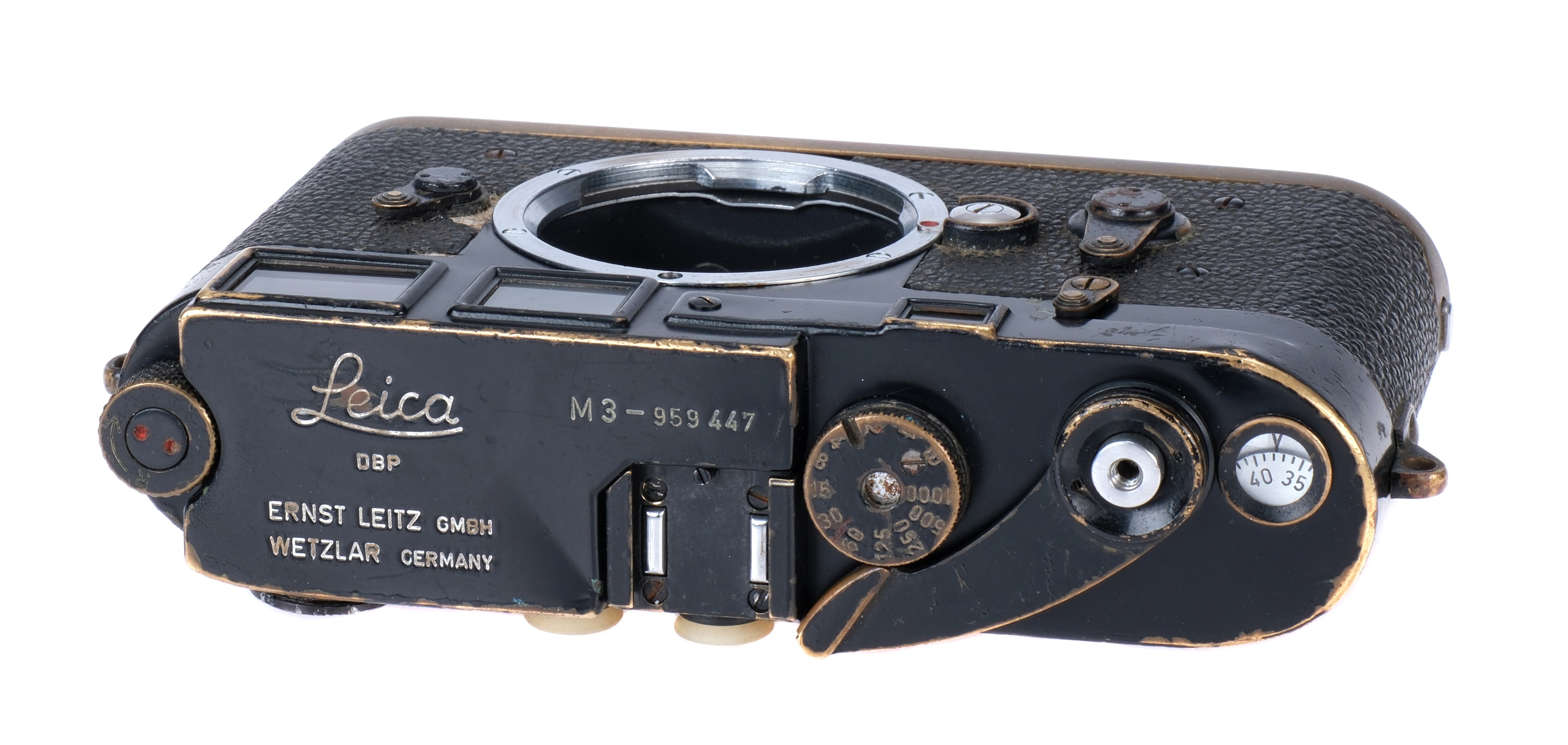The Black Paint Leica M3 Camera
A Legacy of Craftsmanship and Precision
26/06/2024

The Leica M3, introduced in 1954, is celebrated as one of the most iconic rangefinder cameras ever produced. Among the various iterations of the M3, the black paint models hold a special place in the hearts of collectors and photographers alike. These cameras, with their distinctive appearance, have become symbols of photographic excellence and historical significance. Here, we will take a look and explore the legacy of the black paint Leica M3 cameras, delving into who used them, how many were made, and why they are so valuable today.
The Appeal of the Black Paint Leica M3
The Leica M3 was initially produced in a chrome finish in 1955, which was the standard for most of its production run. However, it was not until 1959 a small batch of M3 100 cameras were finished in black paint. The black paint finish was not just a cosmetic preference but also provided practical benefits. The black surface was less reflective than chrome, reducing glare and making it easier for photographers to remain inconspicuous while shooting.

Notable Users of Black Paint Leica M3 Cameras
The black paint Leica M3 cameras were favoured by many renowned photographers and photojournalists, who appreciated their discreet appearance and reliable performance. Some of the most notable users include:
Henri Cartier-Bresson: Often referred to as the father of modern photojournalism, Cartier-Bresson preferred Leica cameras for their portability and precision. His work for Magnum Photos and his influence on the decisive moment in photography make his choice of equipment particularly significant. The black paint M3 was ideal for his candid, street photography style.
David Douglas Duncan: An American photojournalist renowned for his war photography, particularly during the Korean and Vietnam Wars. Duncan's choice of the black paint M3 was driven by the need for a durable, reliable camera that could withstand the rigors of combat zones.
Thomas Hoepker: Another Magnum Photos member, Hoepker used Leica cameras to document major historical events and social issues. His black paint M3 was part of his toolkit for capturing powerful images with subtlety and precision.
Production Numbers and Rarity
The black paint Leica M3 cameras were produced in limited numbers, contributing to their rarity and desirability today. Of the over 225,00 M3's produce, however, only 1320 'officially' left the factory the Leitz Wetlzar factory as black paint.
These cameras were often custom orders or produced in small batches for professional photographers and special markets, such as the news and press. The rarity of these models is further compounded by the fact that many black paint M3s were heavily used by professionals, resulting in fewer surviving examples, let alone in pristine condition.
Below are the official serial number bands and production numbers of the Leica M3 black paint cameras.
Date | Model | Serial Start | Serial End | Batch Produced |
6/3/1959 | M3 Black | 959401 | 959500 | 100 |
3/21/1960 | M3 Black | 993501 | 993750 | 250 |
8/18/1961 | M3 Black | 1038801 | 1039000 | 200 |
10/24/1962 | M3 Black | 1059850 | 1059999 | 150 |
8/5/1963 | M3 Black | 1078501 | 1078800 | 300 |
4/8/1964 | M3 Black | 1097701 | 1097850 | 150 |
11/12/1965 | M3 Black | 1134001 | 1134150 | 150 |
12/2/1966 | M3 Black | 1157591 | 1157600 | 10 |
1/26/1967 | M3 Black | 1158501 | 1158510 | 10 |

The Value of Black Paint Leica M3 Cameras
Several factors contribute to the high value of black paint Leica M3 cameras in today's market:
Historical Significance: The black paint M3s are closely associated with some of the most significant moments in 20th-century photography. Their use by legendary photographers adds a layer of historical and cultural value that transcends mere functionality.
Aesthetic Appeal: The black paint finish, often showing signs of brassing (where the black paint wears away to reveal the brass underneath), is highly prized by collectors. This patina not only signifies the camera's age and use but also enhances its visual appeal.
Rarity: With only a limited number of black paint M3s ever produced, they are much rarer than their chrome counterparts. This scarcity makes them highly sought after by collectors, driving up their market value.
Craftsmanship: Leica cameras are renowned for their build quality and precision engineering. The M3, in particular, is celebrated for its smooth mechanics, bright viewfinder, and robust construction. The black paint models exemplify the pinnacle of Leica's craftsmanship, making them prized possessions.
Provenance: Cameras with documented histories, especially those used by famous photographers, can command even higher prices. Provenance adds a personal narrative to the camera, making it a unique artifact rather than just a piece of equipment.
Leica M3 Black Paint Valuations
The market for vintage Leica cameras, particularly M3 black paint models, has seen significant growth in recent years. Auction results provide a clear indication of their value.
The value of Leica M3 black paint cameras depends heavily on three key factors, batch production, cosmetic condition and provenance. Cameras from the first batch of 100 produced demand a higher price, with Flints displaying this by achieving £63,750 for a 1959 example, serial number 959447 in the May 2024 Fine Photographica auction.
A Leica M3 black paint from 1962-64 would be valued at around around £10,000 - £15,000, being in the same cosmetic condition. If our 1959 Leica M3 black paint was in pristine condition, with a box and hardly ever used, then would be valued at around £70,000 - £100,000.
The rising interest in analogue photography and the appreciation for vintage cameras as collectable items have further fueled ever-rising prices. Collectors and photography enthusiasts alike view these cameras not only as functional tools but also as investments and pieces of art.
If you have an Ilford Witness camera you would like to sell or have valued, please contact us here.